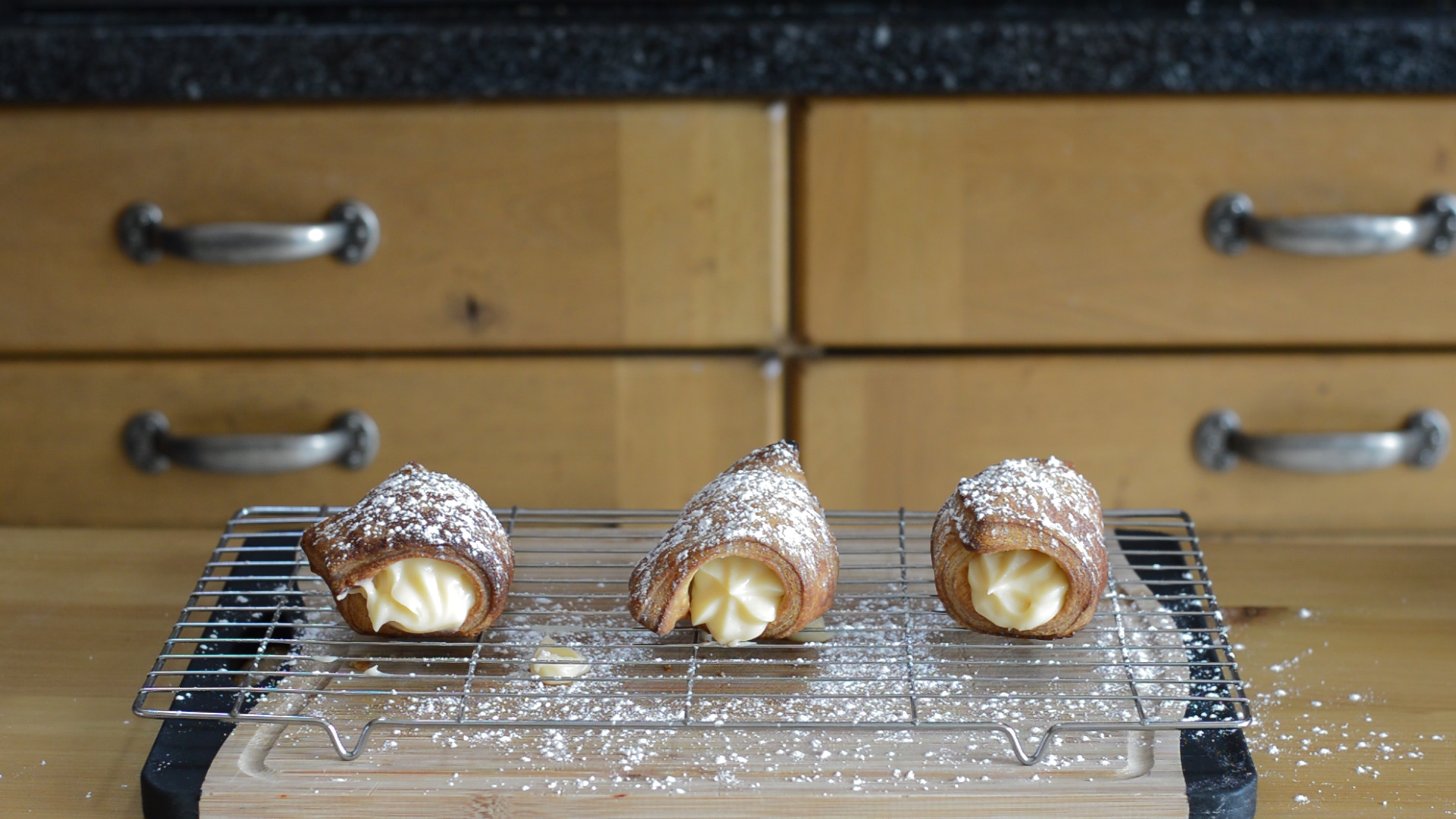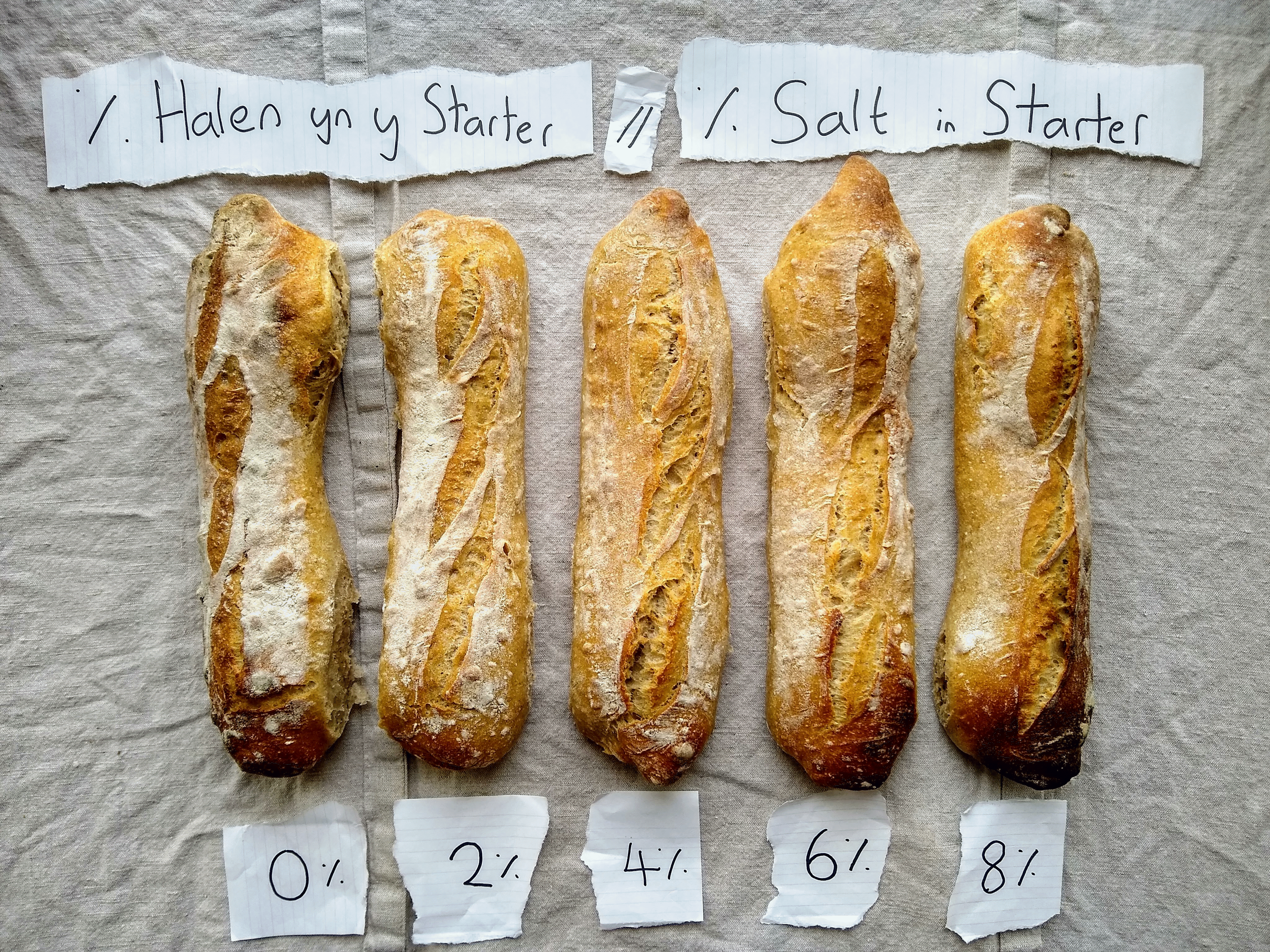Croissant, or Mille-Feuille?
An innocent enough question. An idyllic one, when I was a child.
Food’s power comes from fostering relationships. It comes from the fact that two people eating together, are sharing. Sharing an activity. Sharing clumsy mouthfuls of custard caked pastry. Sharing happiness.
No surprises then that one of my (literal) sweetest memories as a child is walking down Bangor high street, aiming straight for the bakery. We were getting vanilla slices, matching Mille-Feuilles. As I’ve touched upon in my shoe buying lamentations, this would always be a post-shop bakery visit. Removing the sting from hours of walking, shop to shop to shop, by ending our journey, at the bakery.
Today, though my hands (and mouth) are bigger, I still struggle to make one mouthful of Mille-Feuille without showering myself in rocket propelled custard and flaked pastry. This is where the croissant comes into play
Polling on Instagram, I was given a 50/50 split in opinion whether I should make croissants or Mille-Feuille next. Great. Perhaps this is a sign, I thought. Maybe, instead of ignoring half my audience, I could ignore all of them and do something totally irrelevant instead!
Thus the Croillfeuille was born.
Brioche dough laminated to the exact 729 butter layer specification required for Mille-Feuille puff pastry (not 1000 as it turns out). The pastry then got cut into strips before being baked wound around a cylinder mould (a tube of foil with the cardboard pulled out). The idea was that this would produce a pastry with the characteristic croissant spiral shape but with the tender flakyness of Mille-Feuille puff pastry. Best of all, by baking them around a cylinder, they’d come out with a ready baked channel though their centers that could be filled with creme patissiere. Liberally dust with icing sugar and you have, the Croillfeuille
This is Mille-Feuille, without the mess.
Full recipe with all measurements and techniques used, below.
Preparing the butter
The necessary ratio for laminating dough is 1:5 butter to dough. In this recipe, I’ve used 500g of brioche dough, which made about 4 Croillfeuilles, but you can scale up or down as much as you want (although doubling the recipe will double your work!)
Pound your butter (covered with paper) with a rolling pin until flexible and relatively flat [1:10-1:20]
- 100g of butter
- some baking paper
Take the paper around your butter and fold it around the flattened butter to form a square about 4X4 inches
Make sure the paper fully encloses the butter as you fold it, otherwise you’ll end up squeezing it right out as you roll it later.
Roll out the butter to fill the paper square [1:20-1:40]
If the paper square’s tight enough, you should be able to roll out the butter to fill the space, giving you a perfect square of butter.
Let you butter square chill and firm up in the fridge ( ~ 30-60 mins)
Of course, you could just put it in the freezer, but this is a risky game. The butter’s will cool rapidly due to it’s increased surface area and will quickly freeze if left unattended. You;ll then have to wait for it to that so as to be able to work it again (and there’s no guarantee that freezing your butter won’t damage it’s and therefore your pastry’s structure).
Encasing the butter
Laminating is simply the process of wrapping butter in dough and folding it to produce layers. The process produces alternating layers of dough and butter, which when baked, harden and ,melt respectively, to create the characteristic flakes of puff pastry.
Move on to this step once the butter’s chilled (or defrosted if you’ve been naughty and impatient).
Roll out your dough to form a 6×6 inch square
In terms of actual sizes and measuring, your dough is fine as long as it’s as taller/wider than the butter’s diagonal length (the hypotenuse of the butter square, that is i.e. h^2 = 4^2 + 4^2 = 32 < 6 x 6, hence 4 inch butter square fits diagonally in a 6 inch dough square)
- 500g brioche dough
Unwrap and place the butter square straight from the fridge, onto the center of the dough square, but at a 45° [2:00-2:20]
Each corner to of the butter square should almost touch the mid point of the dough square’s sides…just look at the video 😛
Trim the edges of the dough square to straighten them out and fold each dough corner into the center of the butter square…again just look at the video [2:15-2:35]
The reason we trim the dough here is to keep things tidy and prevent excessive overlap, which could lead to an uneven pastry. Precision is what lead to perfection here.
The dough is now ready to be laminated.
Laminating the dough
To make life (and this explanation) a little easier, I’ve listed the steps to repeat below.
1. Roll the dough out into a rectangle (on floured surface), dusting any flour of the top.
We need to minimize the amount of flour on the top surface so that the dough sticks to its self once folded in step 2.
2. Look at your dough as if it were in three sections. Fold one third in from the side, over the center third. Then, take the second outer third, and fold it into the center too, over the other two folded thirds [3:10-3:17]
Again, video!
3. Rotate the folded dough 90°.
You’ll then need to do the above steps 3 times for croissant dough, 6 times for Mille-Feuille puff pastry.
To be fair, a croissant is technically 32 layers, not 3x3x3=27, so it actually requires 2x2x3x3 folds. Your more than welcome to follow the maths if you want. 😛
At any point during this process, if the dough’s getting too warm and soft, refrigerate it. An hour or so should do for each chilling period.
The maximum number of times I’m comfortable repeating folds is 3 times before I have to chill it again. To make puff pastry, this means performing the above steps 3 times, twice over. This means chilling the dough after the first 3 sets of 3 folds, then doing it again and chilling after the second repetition for the 4th, 5th and 6th set of folds…simple.
Shaping the Croillfeuille
Remove the laminated dough from the fridge and roll out slightly into a long-ish rectangle, about 1/4 inch thick [5:15-5:20]
Cut the rectangle lengthwise into 4 strips [5:20-5:25]
You may be able to get a few more strips out of it by cutting them thinner, but don’t go too thin. Otherwise there won’t be sufficient overlap when you wind them round the mould to form a spiral.
Wrap the strips around the (lined) cylinder mould at a slight angle [5:28-5:45]
My ‘mould’ was just a roll of ffoil without a center, but for the time it took to make, I should’ve just bought cannoli moulds. However, the foil log does work, granted you line it with baking paper first.
Bruch the pastires with an equal parts sugar syrup (same weight of sugar and water).
You can also use this syrup to stick the flappy open ends of the rolled strips down, to make sure they stick and don’t unfurl during baking
Bake on a lined baking tray, starting off at 200°C ( 8 mins ) before finishing low on around 160°C ( 12 mins)
The idea here is that you hit the pastry with high heat to start with, to get rapid expansion as the butter melts and water evaporate, then finish then off on a lower temp so that they set fully without burning.
Remove from the oven, slide them off the mould and let them cool completely on a wire rack.
Finishing the Croillfeuilles
Once the pastry shells have cooled completely, fill them up with plenty of creme patissiere.
The easiest way to pipe is sideways, filling them horizontally. Filling them vertically left more custard on the floor than inside the shells.
- 1 piping bag of creme patissiere (recipe on the way)
Finish with a dusting of Icing sugar.
My thinking here was that a dusting of sugar would still deliver that familiar, overly sweet sensation, without all the stickiness that icing entails. All in the name of mess-reduction.
More to Read
That’s it then! The Croillfeuille, the next big food trend of the century am sure. For more brioche, custard and questionable ideas, there’s brioche pizza if you’ve not tried it, or maybe it’s the Inverse Apple Crumble that takes your fancy?




